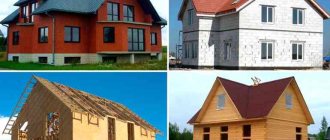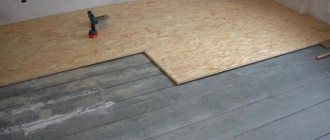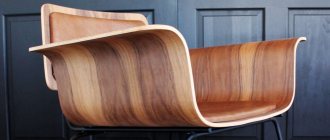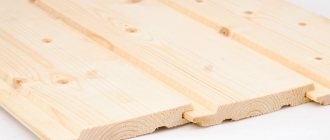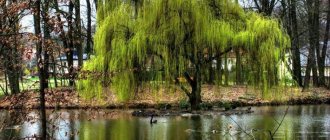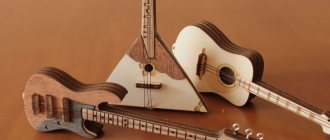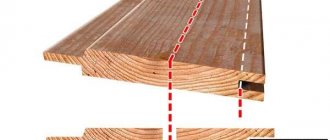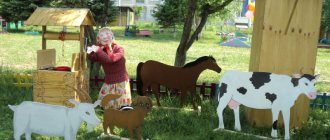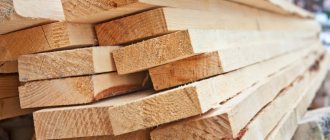Plywood is familiar to everyone. Until recently, a lot of very necessary and completely useless products were produced from material made from veneer. There were times when plywood was used in aircraft construction, and it was used to make fuselages and load-bearing planes of aircraft. This indicates that plywood is a very technologically advanced and quite durable material, which is why today it remains one of the most popular building materials, despite the emergence of more modern products.
The use of plywood in the aviation industry, shipbuilding, electrical engineering, construction and furniture production indicates the high manufacturability, strength and demand of this material.
What is plywood
Plywood is a wood-based panel material known to mankind for centuries. Plywood sheets consist of several thinner layers of natural wood glued together. The thicker the plywood sheet, the more layers it contains.
It is a universal material with a wide range of applications: from wall and floor coverings to molds for concrete structures, designer furniture and packaging.
Plywood is significantly stronger than some other wood-based sheet materials. Its strength is ensured structurally: the “grain” of each layer is directed differently from the direction of the fibers of neighboring layers. The alternating direction of the fibers of each layer is called the cross direction, and can be 90 degrees, that is, a right angle. This means that the fibers are directed perpendicularly. However, the angle can start from 30 degrees depending on the production technology.
In thick plywood, seven layers can be spaced in 30-degree increments: 0, 30, 60, 90, 120, 150 and 180 degrees.
What does this alternation of fiber direction give?
- The likelihood of sheet splitting is reduced.
- The possibility of expansion and shrinkage of the material is reduced and dimensional stability is ensured.
- The strength of the sheet increases in all directions, over the entire area.
Purpose of plates and their varieties
Before we look at the types of panels, let's figure out what an OSB board is? So, OSB is a material consisting of three compressed layers. It consists of elongated chips, which are waste from aspen or pine. The strength of the panel lies precisely in the fact that in the middle layer the chips are located at right angles to the top and bottom layers, and in the covering layers, on the contrary, along. All layers can withstand press at high temperatures, and the binding waterproof impregnations are resins and waxes.
There are four types of OSB boards. Let's look at each of them:
- OSB1 - used for the production of furniture products. Covering walls and floors with panels is not recommended due to low density and fear of moisture.
- OSB2 is more dense, unlike the first type, but is also susceptible to moisture. The characteristics of the panels allow their use for cladding indoors with an average level of humidity.
- OSB3 is the most popular type due to its excellent moisture resistance. Under prolonged exposure to water, it begins to deform and if used for exterior work, the material must be painted.
- OSB4 - has the best characteristics and is not at all afraid of moisture. The casing does not deform even with prolonged contact with water.
Let's take a look at the small table and look at the strength and moisture resistance that osb boards have:
| Classification | Strength | Moisture resistance | % maximum swelling | Yellow is low, green is high, red is super high. |
| OSB 1 | 25 | |||
| OSB 2 | 20 | |||
| OSB 3 | 15 | |||
| OSB 4 | 12 |
A Brief History of Plywood
The earliest historical examples of wooden plywood are known from the times of Ancient Egypt and date back to 3500 BC. They were made from sawn veneer and glued crosswise. In its properties, ancient Egyptian plywood differed little from modern ones.
A thousand years ago, plywood sheets were actively used in China for the production of furniture. In Europe, plywood began to be used much later: examples of furniture and wall panels are known in France and Great Britain. The earliest examples of European plywood were made from high-quality wood. Plywood was used to make cabinets, chests, countertops and doors.
Softwood plywood for use in construction work only appeared in the 20th century.
offers to buy plywood at the lowest prices.
Is fiberboard material harmful?
Many people know that wood chips are used for the base of fiberboard, less often cellulose waste and stems of coarse plants, cotton or corn. As we can see, natural materials are used as the base raw materials. But in this case, we should also consider binding hygroscopic and antiseptic substances. What can be added to wood pulp when making fiberboard? First of all, it is paraffin; it is a substance that consists of a mixture of saturated hydrocarbons. Next comes an emulsion of non-aggressive synthetic resin. Rosin, which is produced from pine wood, is also added. Bitumen is also present - a mixture of hydrocarbons and its derivatives. Pectol is a product of tall oil processing. And finally, gypsum, which is a sulfate mineral.
All of the above substances do not emit any harmful fumes. Phenol-formaldehyde, which ruined the reputation of the board as such, can only be found in chipboard, and in the “pirated” version of production. In our country, the use of phenol-formaldehyde has long been prohibited on the basis of relevant regulations.
Drawing a conclusion from everything previously said, we can assume that, regardless of class or characteristics, completely safe plywood does not exist. But, according to all the studies conducted, we can say that ordinary plywood is the least harmful. This is not a shortage, it can be found in any hardware store, but it is not always suitable for a particular job. As for the USB stove, most stores sell far from environmentally friendly options, which will certainly help solve construction problems, but they should be used very carefully.
What is it used for?
The range of applications for plywood is truly enormous. It is used for cladding, formwork, for the production of furniture, packaging, sports and play equipment. Another unexpected area is the production of bodies for some vehicles, including in aircraft construction. Of course, such tasks require unusual plywood; we will consider this issue below.
Thinner varieties of plywood are used in modeling and creativity: the artist coats thin plywood with gypsum sealant as a primer, after which he can paint on such a sheet.
Manufacturability of application
The technology for using plywood and OSB is almost the same. Sheets are cut on special machines or with hand tools. The processing of the ends of the parts is also very similar. But OSB produces more flakes when cutting with a jigsaw or a non-specialized circular saw. Therefore, to obtain a smooth edge, deeper grinding of the ends is required.
The complexity of plate processing depends on the type of plate and surface requirements. First-class sanded plywood does not require processing.
OSB does not provide such an opportunity. Therefore, plywood should be considered a more technologically advanced material. The ability to hold fasteners is equally good for these materials.
Characteristics
Strength
The strength of plywood is high: it is resistant to impact loads, yet it is lightweight, easy to cut and can be machined.
Due to these properties, plywood is used as a sheet material for forming or covering large flat volumetric structures, walls, roofs, floors, and containers.
Suitability for demanding work
Plywood is easy to process. It is used to make not only rough formwork or simple slabs for covering walls or floors, but also complex models, wooden puzzles, and designer carved boxes. See what miracles craftsmen can do with a hacksaw and a jigsaw!
Scale of application
The low price, ease of processing and high user properties of plywood make it a practical material for large-scale work. Do you need to sheathe walls, ceilings, floors with a minimum of seams and joints? — The first thing that comes to mind is plywood. From thick racks for storing goods to thin cladding in designer interiors.
Features of OSB
Despite some visual similarities between plywood and OSB boards, these are completely different materials with different properties.
The main competition for plywood is oriented strand boards, which can be called its successors, since they have a multilayer structure, and each layer is oriented perpendicular to the neighboring one. Non-professionals often call OSB plywood, although in addition to some similarities, these materials have a number of significant differences. They are made by hot pressing not veneer, but thin shavings that are bonded together with synthetic fibers, resins and paraffins.
It would seem that OSB should be similar in properties to chipboard, but this is not the case. Particle boards are made from fine sawdust, which is a waste product from wood processing, which negatively affects their strength and moisture resistance. This is where you can finish the review of materials similar to plywood and move on to a description of its brands, grades and properties in order to determine what kind of plywood is needed for floor installation.
How plywood is made
To produce plywood, you need high-quality straight logs of large diameter. The bark is removed from such a trunk, and the trunk itself is mounted on a special lathe, where the cutter, when rotating the trunk, removes a solid sheet or layer of wood of a given thickness.
This wood sheet is cut according to a given pattern, with a certain length and width, and the surface is scanned for defects.
From such sheets, layers of plywood sheets are made, glued and pressed. The resulting slabs are cut to their final size.
The final operation is sanding, smoothing the surface of the plywood sheet. In some cases, the sheet is coated with a special compound, for example, melamine or acrylic, and the edges of the sheet are sealed.
Aesthetics
When comparing the appearance of materials, deciding which is better, OSB or plywood for the floor, for wall cladding or for furniture, several factors should be taken into account.
At first glance, plywood seems more aesthetically pleasing than OSB. But in reality it is very many-sided. Its type is determined by the type of veneer of the outer layers and its quality. Low-grade technical plywood can hardly be used for interior decoration or for facade furniture parts. It has many knots and other defects.
For furniture and finishing work, grade 1-2 plywood is used, on the surface of which there are very few or no defects. In terms of aesthetic qualities, this material is not inferior to solid wood. Plywood of lower grades in its pure form is unsuitable for finishing, except for its use in non-standard design solutions.
OSB can also be used in non-standard finishing. With the help of special processing, its surface structure can be turned into a nice decoration. But still, particle boards are more appropriate as a structural or underlying material that does not catch the eye.
Types of plywood
There are a lot of types of plywood, practically for any purpose and purpose. It will not be possible to consider everything in detail in one article; we will only list the main ones.
Softwood plywood
One of the most common species around the world. Used primarily in construction and industry.
Hardwood plywood
This plywood has high hardness and strength compared to coniferous plywood, which is softer and more viscous. It is highly resistant to damage and wear and is suitable for the toughest environments including floors and walls.
In Russia, the most common plywood of this type is birch.
Tropical plywood
It is made from tropical wood from Asia, Africa, and South America. It is characterized by high viscosity, combined with strength and uniformity of layers. Thanks to these characteristics, tropical plywood is used abroad in construction, industry, furniture production, and design.
Tropical plywood looks very attractive even without additional processing.
Aviation plywood
This high-strength plywood is made from mahogany or birch, or a combination of both, and glued together with a heat- and moisture-resistant adhesive.
During World War II, aircraft plywood was used in aircraft construction, and today it is used where strength and overload resistance are needed.
Decorative plywood
For its production, hardwood is used, and the scope of application of finished sheets is furniture, wall panels, and various design projects.
It is additionally covered with veneer, plastic or paper, impregnated with resins.
Marine plywood
It is a good choice for the production of boats and any items that come into contact with moisture and water. Marine plywood is highly resistant to fungus, delamination and deformation when exposed to moisture.
The main disadvantage of such plywood is its high cost. It is much more expensive than other varieties.
Laminated plywood
The sheet is covered with a hot laminate. This material is used for formwork, for example, concrete structures, holding brick arches and other forms that use a liquid plastic solution before it hardens.
Laminated plywood is also used for decorative purposes, as well as where a non-slip surface is needed.
Division by variety
Types of plywood.
Plywood sheets are divided by grade. There are 5 types of key material in total. The highest grade is indexed with the letter E (elite). Poor quality veneer is marked with the Roman numeral IV. Products are sorted as follows:
- veneer, indicated by the number IV, may have all possible defects - from knots to surface irregularities; the manufacturer can only guarantee high-quality gluing of the layers;
- grade III is used for the manufacture of hidden structures;
- grade II allows some defects on the surface, but they can be easily eliminated with coating materials without additional processing;
- on first grade plywood there may be single knots, the diameter of which does not exceed 8 mm, and small dark veins;
- a surface devoid of visible defects, knots, veins and wormholes distinguishes grade E plywood.
The grade of plywood is marked not by one number or letter, but by a combination of them, depending on the condition of its front and back veneer. There is no material with the E/E combination, but the rest of the markings look like this: E/I, I/I, I/II, II/II, II/III, II/IV, III/III, III/IV, IV/IV . Instead of numbers, varieties can be marked with Latin letters A, B, C (E/A, etc.).
Criterias of choice
The choice depends primarily on the purpose and operating conditions
. When choosing plywood, several parameters are taken into account:
- They purchase products from well-known brands and take into account the location of the factory.
- The purposes of use determine the appearance, so for visible furniture facades they buy products of the highest quality, and for wall coverings it is more economical to choose products with one processed side.
- Operating conditions - only moisture-resistant and laminated plywood is suitable for outdoor use.
- Size , based on preliminary calculations, a product is selected in such a format that in the end there will be a minimum of waste.
An important factor is the price , which is higher than that of other sheet materials. For example, it is better to choose chipboard for furniture, and cement particle boards for cladding external walls.
